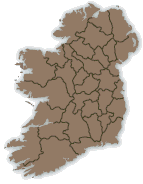An buachaill aimsire agus an cailín (cuid 2) - Séamas Ó Scolaí
Recording: [Download audio file]
[Download AIFF audio file (of processed ‘user’ version)]
[Download AIFF audio file (of archive version)]
Transcript
Agus tréis an tsuipéir a ithe do chuadar ansan a chodladh. D'fhan sé i dteannta an fheirmeora ar feadh chúig mbliana. Agus nuair a bhí na chúig bhliana suas do thug an feirmeoir a thuarastal dó agus níosa mhó ná a thuill sé. Tháini' sé abhaile ag triall ar a mhnaoi. Is d'fháilthigh sí roimis.
"Do (shílíos)," ar sise, "go rabhais marbh fadó," ar sise.
"Dá mbeinn," ar seisean, "ní bheinn anso anois," ar seisean.
"Ar thugais aon chabhair ná chúnamh chugham?" ar sise.
"Ó, do thugas," ar seisean. "(...) Ní aithním an leanbh in aon chor," (ar seisean), "d'fhás sé chomh mór san," ar seisean.
Chuir sé a lámh ina phóca agus do chaith sé an sparán ar an mbord. D'oscail sí é. "Ó, do thugais mo dhóthain ag triall orm," ar sise. "Go raibh maith agat," ar sise.
(...) (a bhfuil de) scéal críochnaithe agam anois.
Translation
And after eating supper they then went to sleep. He stayed with the farmer for five years. And when the five years were up the farmer gave him his wages and more than he had earned. He came home to see his wife. And she welcomed him.
"I thought(?)," she said, "you had died long ago," she said.
"If I had died," said he, "I wouldn't be here now," he said.
"Did you bring any help or assistance to me?" she said.
"Oh, I did," he said. "(...) I don't recognize the child at all," he said, "he grew so much," he said.
He put his hand in his pocket and he threw the purse onto the table. She opened it. "Oh, you brought plenty back to me," she said. "Thank you," she said.
(...) I have finished as much of (?) the story as I have now.
Commentary
There are many narratives in international folktales that revolve around a servant or farmhand taking up service for a period of time, but most contain some kind of motif, action or anecdote as part of the story. For example, stories classified under ATU 1000-1029 Labour contract concern arrangements, bargains or deals between a master and farmhand concerning a period of service. See Hans Jorg Uther, The types of international folktales: a classification and bibliography (3 vols, Helsinki, 2004). The current example, together with part 1, may be generally based on such a tale, but it does not seem to have any particular events of consequence as part of the plot. It simply gives the account of a young man who takes up service, earns money, and returns home to his wife after his contract has expired. This was the reality for some Irish people at the time of the telling of this tale, and migrant farm workers or servants would have formed an important part of the economy. See Cormac Ó Gráda, 'Seasonal migration and post-famine adjustment in the west of Ireland', Studia Hibernica 13 (1973), 48-76.
Title in English: The servant boy and the girl (part 2)
Digital version published by: Doegen Records Web Project, Royal Irish Academy
Description of the Recording:
Speaker:
Séamas
Ó Scolaí from Co. Cork
Person who made the recording:
Wilhelm Doegen
Organizer and administrator of the recording scheme: The Royal Irish Academy
In collaboration with: Lautabteilung, Preußische Staatsbibliothek (now Lautarchiv,
Humboldt-Universität zu Berlin)
Recorded on 12-09-1928 at 15:15:00 in Convent
of Mercy, Killarney (office). Recorded on 12-09-1928 at 15:15:00 in Convent
of Mercy, Killarney (office).
Archive recording (ID LA_1079d2, from a shellac disk stored at the
Royal Irish Academy) is 01:02 minutes
long. Archive recording (ID LA_1079d2, from a shellac disk stored at the
Royal Irish Academy) is 01:02 minutes
long.
User recording (ID LA_1079d2, from a shellac disk stored at the Royal
Irish Academy) is 00:59 minutes long. User recording (ID LA_1079d2, from a shellac disk stored at the Royal
Irish Academy) is 00:59 minutes long.





